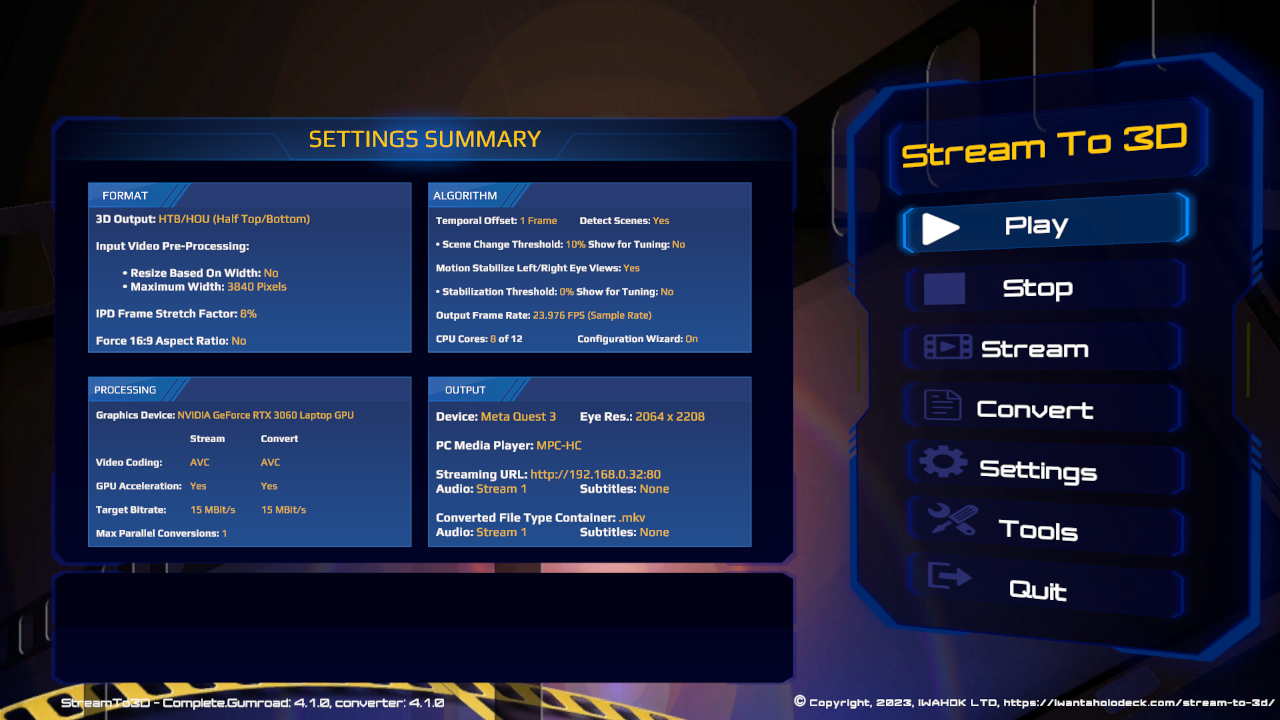Welcome to Stream to 3D – Your Portal to Immersive 3D Video

Thank you for choosing Stream to 3D, a specialised utility designed to bring 2D video content into vivid three-dimensional life. Whether you’re looking to enjoy immersive 3D movies in a VR headset, convert your favourite videos for a 3D TV, or stream to various media players, Stream to 3D aims to deliver a powerful and flexible experience that goes beyond traditional video playback.
Important Considerations – Before You Begin
Unlike many standard PC games or video apps, Stream to 3D operates within a complex technological ecosystem. It works hand-in-hand with:
- External Media Players (MPC-HC, PotPlayer, VLC)
- VR Platforms (Virtual Desktop, Bigscreen, or native VR media players like Pigasus)
- Underlying Hardware and Software Environments (GPU drivers, codecs, network configurations, and display devices)
Because we support multiple hardware types, VR setups, and network locations for source media, achieving the best experience may require some initial configuration, troubleshooting, or guidance. We strongly recommend reviewing our documentation and set-up wizards and taking a moment to ensure that your PC and peripherals are correctly configured.
Before Leaving a Review – Contact Support
If you encounter difficulties along the way—be they VR headset streaming issues, hardware limitations, or unclear configurations—please reach out to us via Discord or email. We’re committed to helping you find solutions. By contacting support first, you’ll likely achieve the intended 3D experience and avoid frustration. Our goal is for you to enjoy the richness of 3D content at its best, and we’re here to help every step of the way.
Launching Stream to 3D
- From Steam: When installed from the Steam Store, a desktop shortcut is automatically created. You can also launch Stream to 3D from your Steam library.
- From Other Stores: If you’ve acquired Stream to 3D elsewhere, you’ll typically find the executable at:
C:\Program Files\StreamTo3D\StreamTo3D.exe
Feel free to create your own desktop shortcut for convenience.
Upon first launch, Stream to 3D defaults to full-screen mode, making it easier for VR scenarios where tools like Virtual Desktop or Bigscreen are used to mirror the desktop into your headset. You can toggle between full-screen and windowed mode at any time by pressing ALT+Enter.
Core Features and Functions
- Real-time Conversion & Playback: Instantly transform 2D video into 3D and display it on your PC using compatible media players. Stream the resulting desktop image into your VR headset or output it to a 3D TV or projector.
- File-Based 3D Conversion: Convert video files directly into 3D formats for offline viewing or portable use across various devices.
- Network Streaming: Send video to remote players, including VR media players, Fire TV Stick apps, and more, without requiring a VR desktop environment.
Why Read the Documentation?
Our built-in Configuration Wizard tackles a wide range of use cases, but given the myriad of potential hardware and software combinations, additional guidance can help you achieve optimal results. Inside this documentation, you’ll find:
- Step-by-step configuration tutorials
- Tips for troubleshooting complex hardware setups
- Links to demonstration videos and advanced usage scenarios
Next Steps
Use the links below to explore detailed guidance:
- Settings
- PC Screen or Live Video Conversion to 3D (New for Release 5)
- Real-time Conversion and Playback
- Video File Conversion
- Streaming
Support and Assistance
If you need further help, our Support Page provides direct links to our Discord community and email support. We’re here to assist you in making the most of Stream to 3D, ensuring that the complexity behind the scenes translates into a smooth, immersive 3D viewing experience for you.